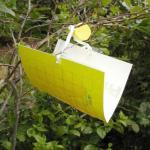Blueberry IPM - Blueberry Maggot Fly
Blueberry Maggot Fly (Rhagoletis mendax)
ID/Life Cycle:
The adult Blueberry Maggot fly (BBM), is closely related to Apple Maggot Fly (AMF) and similar in size to a common house fly. Males and females are identical except females are larger. BBM is black in color with a white spot on the thorax and a distinctive ‘W’ or ‘M’ pattern of dark and clear bands on its wings. There are a few other flies with similar patterns on their wings so it is important to know the difference. The larvae or maggots are small, white, legless, and are found inside infested fruit. Pupae are oval, hard, light brown and found 1-2” deep in the soil beneath the bushes.


This insect overwinters as pupae in the soil beneath the blueberry bushes. The timing of emergence of overwintering adults coincides with the ripening of blueberry fruit and spans several weeks, which extends their period of activity in the field. Females lay their eggs singly beneath the surface of a ripening berry. The emerging larva feeds inside the berries for a two-week period. When full grown, the larva drops to the ground, if the berry has not already fallen. It pupates in the soil, where it will remain for the winter. There is one generation per year.
Damage:
Female flies lay eggs under the fruit skin just as the fruit begins to turn blue and larvae feed within the fruit. Maggots feeding within developing fruits render fruit unmarketable. Berries become soft and mushy. Undetected infested berries contaminate pack-out.
Management
Monitoring:
Yellow sticky rectangle traps can be used to monitor BBM populations in the planting. Traps are placed in the top 1/3 of the bush in an area where foliage will not obscure it from view. Traps should be placed facing downward with an ammonium acetate lure attached (see figure below). Because ammonium acetate volatilize off the traps, the lures must be changed every 2 weeks.
In low-pressure plantings (e.g., for low risk situations where BBM has not been a serious pest in the past), 2 traps per acre is recommended. In plantings where higher intensity monitoring is desired (e.g., in higher risk situations where BBM has been significant in the past year or in organic production), traps can be placed in 3-4 bushes around the perimeter of a 1-acre planting and another 1-2 traps on interior bushes.[AA1] [MOU2]

Bushes with traps should be marked with flagging tape so they can be easily found. Traps should be set out prior to any fruit showing color and checked every few days to determine when BBM flies are becoming active.
Sustained catch of the BBM in traps indicates that it is an optimal time to make an insecticide treatment; sustained catch means not just the first one or two flies, but consistent catch of several flies per week.
Control strategies
Cultural/Biological:
- Remove wild hosts in the vicinity of commercial planting when possible.
- Frequent thorough picking with minimal fruit drop will help keep BBM populations lower.
- Avoid composting infested fruit as eggs, larvae and pupae can survive relatively high temperature (up to 120˚F).
- Prune to achieve small, open bushes with good sunlight penetration through the canopy, reducing shading on the soil surface to generate a less favorable habitat for build-up of this pest.
- Set out a high density of traps (1 trap per bush) in small plantings to trap-out this insect.
Chemical:
- See New England Small Fruit Management Guide for currently recommended spray materials for BBM.
- Apply recommended insecticides (conventional or OMRI Organic), when first BBM is found (in High Risk situations), or when trap catches indicate a sustained population (Lower Risk situations).
- Consider that timing of recommended insecticides (conventional and organic) may overlap with those recommended for Spotted Wing Drosophila (SWD), and time sprays accordingly.
- If repeat applications are needed, rotate insecticides from different IRAC groups to reduce the chance of resistance development in the pest.
- Be aware of pre-harvest intervals for materials applied close to harvest.
- Preserve natural enemies whenever possible by selecting spray materials that are less toxic to beneficial insects.
Date: January 2020
Author(s): Sonia Schloemann and Jaime Piñero, UMass Extension
Visit our website: http://ag.umass.edu/fruit
Additional information available on the MYIPM app: https://apps.bugwood.org/apps/myipmseries/
Note: This information is for educational purposes only and is reviewed regularly for accuracy. References to commercial products or trade names are for the reader’s information. No endorsement is implied, nor is discrimination intended against similar products. For pesticide products please consult product labels for rates, application instructions and safety precautions. The label is the law. Users of these products assume all associated risks.
This work was supported in part by funding provided by USDA NIFA Extension Implementation Program, Award No. 2017-70006-27137